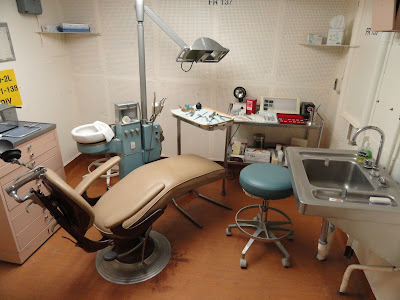








Say what you will about Americans, they are fiercely proud of their history and their Armed Forces. The USS Lexington is docked at Corpus Christie and has numerous volunteers on duty to teach the students on their field trips as well as the general public. It was a wonderful afternoon.
USS Lexington (CV/CVA/CVS/CVT/AVT-16), known as "The Blue Ghost", is one of 24 Essex-class aircraft carriers built during World War II for the United States Navy. The ship, the fifth US Navy ship to bear the name, is named in honor of the Revolutionary War Battle of Lexington. She was originally to have been named Cabot, but she was renamed while under construction to commemorate USS Lexington (CV-2), lost in the Battle of the Coral Sea in May 1942.[1]
Lexington sailed to raid Kwajalein on 4 December. Her morning strike destroyed the SS Kembu Maru, damaged two cruisers, and accounted for 30 enemy aircraft. Her gunners splashed two of the enemy torpedo planes that attacked at midday, but were ordered not to open fire at night as the Admiral[who?] then in command believed it would give their position away (He was later replaced). At 1920 that night, a major air attack began while the task force was under way off Kwajalein. At 2322, parachute flares from Japanese planes silhouetted the carrier, and 10 minutes later she was hit by a torpedo on the starboard side, knocking out her steering gear. Nine people were killed, two on the fantail and seven in the Chief Petty Officers mess room, which was a repair party station during general quarters. Four members of the affected repair party survived because they were sitting on a couch that apparently absorbed the shock of the explosion. Settling 5 feet (2 m) by the stern, the carrier began circling to port amidst dense clouds of smoke pouring from ruptured tanks aft. To maintain water tight integrity, damage control crews were ordered to seal the damaged compartments and welded them shut applying heavy steel plates where needed. An emergency hand-operated steering unit was quickly devised, and Lexington made Pearl Harbor for emergency repairs, arriving on 9 December. She reached Bremerton, Washington on 22 December for full repairs, completed on 20 February 1944. The error in judgment concerning opening fire at night was never repeated again, as gun crews were then ordered to open fire anytime the ship came under attack. The 40 mm "Quads" were most effective from then on. The "Blue Ghost" was reported sunk by Japan's Tokyo Rose – as she would come to say again and again, the ship sank beneath the deep blue seas.
She was decommissioned in 1991, remaining active longer than any other Essex-class ship, and was donated for use as a museum ship in Corpus Christi, Texas. Lexington was designated a National Historic Landmark in 2003. Though her surviving sisterships Yorktown, Intrepid, and Hornet carry lower hull numbers,
No comments:
Post a Comment